This simple and old fashioned recipe for Strawberry Jam without pectin is the perfect way to preserve fresh, seasonal strawberries! This no pectin recipe uses just 2 ingredients, and can be made with or without lemon juice. Step-by-step instructions guide you if you're new to canning, or you can follow the freezer jam method if you prefer!

I've been canning and preserving for close to a decade now, and one of the very first things I made was strawberry jam! Before I invested in lots of canning equipment to learn this new skill, I tried out a few recipes that I didn't need much in the way of special equipment and ingredients for.
This old fashioned strawberry jam without pectin is one of those recipes! First of all, I didn't need to track down any of that pectin I kept hearing about, and second of all, it was a great place to start off. Not only did we LOVE strawberry jam, but we also happened to have lots of strawberries thanks to a recent trip to the U-pick.
Shortly after making my first batch of no pectin strawberry jam I began investing in canning equipment, tools, and of course: different types of pectin. After a few more attempts, I started making my favorite Low Sugar Strawberry Jam, and now I proudly call myself a canning enthusiast.
And so I wanted to share that recipe that first got me started in the world of canning, and I hope it opens a window of opportunity for you to do the same. Canning is not only a fun and rewarding hobby, but it's a productive one too! With just a bit of work (okay, maybe a lot!), you can put up hundreds of jars of food for your family using Farmer's market finds, or even produce you grow in your own garden!
What Makes This Recipe Old Fashioned?
- There are no specialty products needed, just good ol' fashioned strawberries and sugar.
- Great Grandma probably didn't run to the store to buy pectin, and you don't need to either!
- Super simple with just 2 basic ingredients, or 3 if you include the lemon juice.
- A longer process heritage style recipe that involves checking the gelling stage, just like Great Grandma used to make!
Ingredients and Equipment

- Strawberries: The freshest, juiciest strawberries are recommended when it comes to canning and preserving. If you can get your your local U-pick during strawberry season, that's the best quality for making jam. If not, source some good quality store bought strawberries that are small and deep red in color.
- Sugar: This is the main means that the jam is preserved through, so it's important to use sugar. You can absolutely use organic cane sugar if preferred. Sugar preserves the color, quality, and taste of the berries perfectly.
- Lemon juice: A little bit of lemon juice is optional, but may help your jam gel a bit quicker!
Tools and Equipment:
- Canning jars: I recommend using pint jars because it's a good size for those of us who make a few PB&J's a week, or enjoy jam and toast often. If you don’t eat as much jam, try using half pint jars. You’ll need to work in batches since they won’t all fit in the canner at once. Alternatively, you can halve the recipe.
- Canning lids and rings: If you’re buying your canning jars new, they should come fitted with lids and rings. Otherwise, you can reuse the rings but you will need new lids.
- Water bath canner: To save space I use my Presto pressure canner as a water bath canner, but if you’re new to canning, you can purchase a water bath canner for a good price at your local big box store or hardware store.
- Canning tools: You will need a magnetic lid lifter, a jar lifter, and a funnel. It’s very easy to find a kit of canning tools. Most of them have jar lifters that just don’t work very well, but this one from Progressive has the jar lifter that I use, as well as a funnel and a lid lifter. I like to use a stainless wide mouth funnel, but a plastic one will do if that’s what you have.
- Clean towels: I like to add a double layer of towels to the counter for when I’m filling my jars, as well as for when I’m transferring them out of the canner. You’ll also need clean towels for wiping the rim of the jars, although you can use a bit of paper towel if you prefer.
How to Make Strawberry Jam Without Pectin
Preparing the Jars, Rings, Lids and Tools
One of the most important elements of canning is ensuring you are working with clean tools and sterilized jars. Once you get into the routine, you’ll find it very simple to prepare for canning your favorite jams, jellies, pickles and more!

To Prepare:
- Wash the jars, rings, and fresh lids with hot soapy water. Rinse well and dry completely.
- Clean any tools you’ll be using like a jar lifter, headspace checker, magnetic lid lifter, etc. Sterilize if needed.
- Just before you prepare your jam, fill your canner with water and bring to a boil. Lower the jars into the hot water and boil for 5-10 minutes. Turn the canner off, keeping your jars submerged in the warm water. Leave them there until you’re ready to start filling them with hot jam.
- Bring a small saucepan of water to a low simmer and add the canning jar lids. Allow to simmer while you prepare your jam, and keep them in the warm water until you’re ready to bottle your low sugar strawberry jam.
Making No Pectin Strawberry Jam
Add your strawberries to a large stainless steel pot and add the sugar. Add the lemon juice, if using. Crush the strawberries with a potato masher until they are well broken down and slightly syrupy.

Add the pot to a heating element and bring to a boil over medium heat, stirring constantly to dissolve sugar. Maintain the strawberries and sugar at a boil, stirring very often, until thickened.
Once the mixture begins to thicken, you may start checking the jam to see if has reached the gel stage.
Testing for Gel Stage
To check the gel stage, take a cold spoon (place in the freezer for 3-4 minutes) and dip it into the jam. If it is still very loose and liquid, the jam has not set. If it slowly sheets off the spoon, with large drops, it is starting to gel. Once it has reached the gel stage, it will form a sheet or flake and a large mass, appearing set and jelly.

During the cooking process, check the gel often, and stir frequently to prevent burning.
Once the gel stage is reached, remove the pot from the heat and skim any foam that has risen to the top off.
Filling and Processing Jars
Remove the warm jars from the canner and place on a clean towel. You’ll need enough water in the canner to cover your jars with an additional 1-2” of space at the top, so add any additional water if needed.
Heat the canner over high heat and bring to a boil. Fit your pint jars with a wide mouth funnel and ladle the jam into the jars to within ¼” headspace.
Wipe the rim of the jar with a clean towel or paper towel to remove any jam residue.

Use a magnetic lid lifter to place a warm, clean lid on the jar. Place a canning ring on the jar and secure it to fingertip tight.
Repeat the process, filling all of the jam jars and placing the lids and rings on in the same manner. Once all of the jars have been filled and topped with a lid and ring combination, they are ready for processing.

Canning
Once the water in your canner has come to a rapid boil, add the jars of jam to the canning rack and lower into the water. Remember, your jars should have some space around them and not be tightly packed. They also should not touch the bottom of the canner at any time.
Place the lid on your canner and wait for the water to return to a boil. Once the water returns to a rapid boil, you can begin your processing time.
Ensure the lid of the canner is in place, and boil for 10 minutes (the time is the same for half pint jars). Once the time is up, turn the heat off and remove the canner from the heating element. Allow to cool for 5 minutes. Once the 5 minutes are up, remove the jars using a jar lifter and place on a double layer of clean towels OR a cooling rack. Put them in a location where they can be undisturbed for 24 hours.
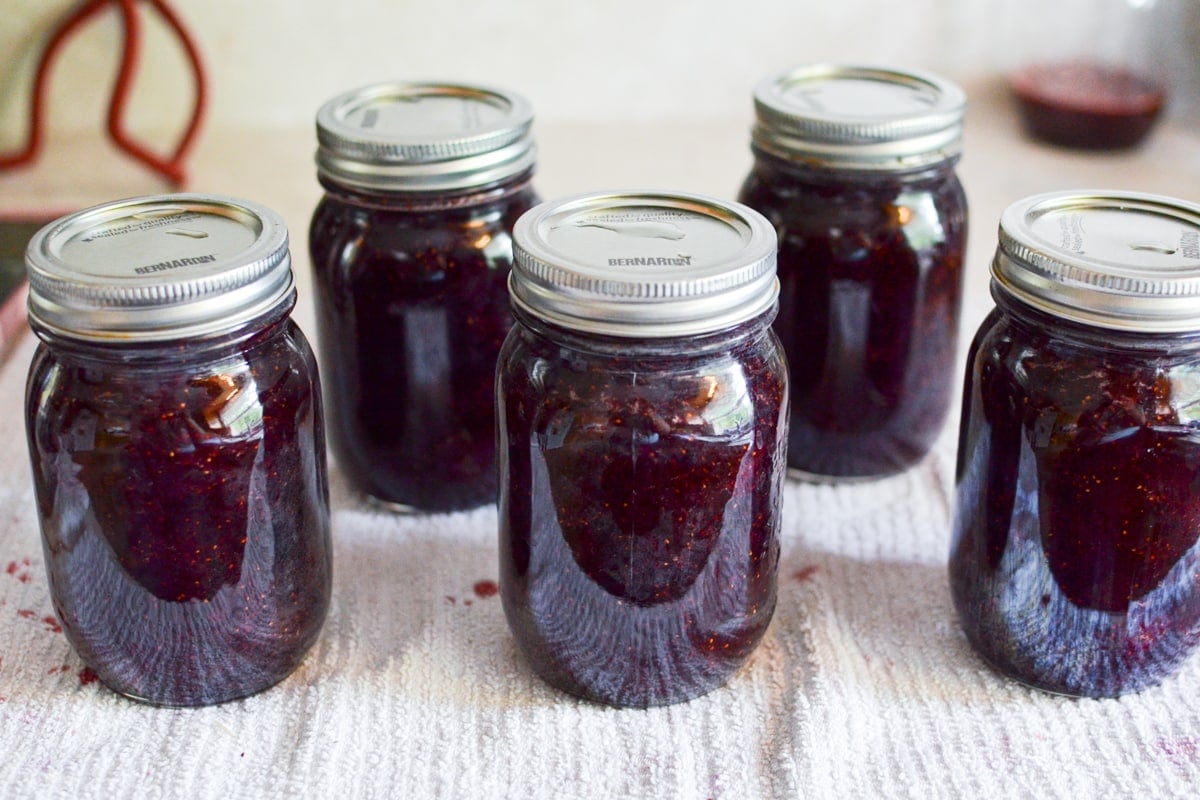
Checking the Seals
After a few minutes, you may start to hear a loud "pop" coming from your jars. This is the sound of them sealing. Typically, the jars will seal within an hour, but you may have some that take longer.
Leave your jars undisturbed for 24 hours before removing the rings, cleaning them, and adding the sealed jars to storage. Don't forget to label them with the type of jam, as well as the preservation date.
Any jars that don’t seal should be added to the fridge and used within 1 month.

Important Tips for Canning Jam
- Water coverage: Make sure your jars are submerged under at least 1-2″ of water once they are placed in the canner.
- Processing time: Don’t start the processing time until the canner (with the jars of jam inside) comes back up to a rolling boil. Then place the lid on and begin the processing time.
- Use a lid: For both bringing the canner to a boil and processing the jam jars, it is recommended to use a lid. This prevents evaporation of water AND maintains a high heat for processing.
- Allow the canner to cool: For the best chance at your jars sealing, I recommend turning the stove off and removing the canner from the heating element. Allow the jars to rest for 5 minutes before removing them from the canner to a cooling rack.
- Don’t touch for 24 hours: After your jars have been removed from the canner, place them on a towel or cooling rack in an area where they will be undisturbed for 24 hours. Do not turn them upside down or shake them during this time.
- Check the seals: Within the first 10 minutes or so of removing your jars from the canner, you should start to hear a “ping” or “pop” noise. When you gently press on the center of the lid, it should be firm and flat or slightly concave. If it still is convex, your jar has not sealed yet. Any jars that have not sealed after the first 5-6 hours should be moved to the fridge and used within the next 1-2 months. With jams and jellies, it’s pretty rare to have more than 1 jar not seal.
- Remove the rings: Before you label and store your jars, remember to remove the outer ring. Leaving the outer ring on can cause the jar to appear sealed when it is not. It can also cause rust, so removing the ring is the best practice for safety and quality.

Variations for Other Flavors
If you want to experiment with other flavors, you can use the same quantity of the following fruits and sugar called for in the recipe:
- Crushed blackberries
- Blueberries
- Raspberries
- Gooseberries
- Boysenberries
- Loganberries
- Or a combination of any of those above, including strawberry.

Can I Make Strawberry Freezer Jam Without Pectin?
Yes! If you prefer to make a freezer jam instead of canning no pectin strawberry jam, just follow this process:
- Make the jam as directed in the recipe.
- Prepare your freezer jam jars by cleaning and sterilizing if you are using glass jars (I recommend plastic though if they are available).
- Keep your jars warm, then add in the prepared jam, leaving at least 1 ½″ headspace to allow for expansion.
- Allow your jars to cool without the lid on (drape a clean cloth over them to keep bugs and dust out). Then, place the lid on and transfer them to the freezer.
- Freeze for up to 12 months, thawing each jar as needed.
Glass Jar Freezing Tips
- Leave at least 1 ½″ of headspace.
- Place the jar in the freezer without a lid on.
- Once it is mostly frozen, add the lid and label.
- Keep them in an area in the freezer where they would go undisturbed.
- Know that at least 1 or 2 will break.
- Wrapping them in a small plastic bag will help contain glass breakage if it happens.

Frequently Asked Questions
Yes, you can make strawberry jam without pectin! But since you are using the old fashioned method, you will have to do things the old fashioned way. That means a longer cook time, and checking for gelling. Although it does take longer and require a bit of skill, the resulting jam is delicious and perfect for canning or freezing.
Yes, you can thicken your jam without pectin. You will need to use an old fashioned method that uses just strawberries, sugar and (occasionally) lemon juice. The process involves cooking the jam and sugar together until it reaches a gel stage. You will have to check frequently with a cold spoon to see if the jam has set.
Using the old fashioned method of cooking the jam with sugar and checking for gelling is a simple and reliable way of setting jam, while still maintaining tested and safe methods that have been put out by the USDA.
More Strawberry Canning Recipes

Old Fashioned Strawberry Jam (Without Pectin)
This easy and old fashioned recipe for strawberry jam without pectin is simple to make and requires just 2 ingredients! The perfect way to preserve fresh, seasonal strawberries.
Ingredients
- 16 cups hulled and chopped strawberries (about 12 cups mashed)
- 9 cups granulated sugar
- ½ cup lemon juice (optional)
Instructions
- Prepare your jars, rids, and lids by washing them in hot soapy water. Rinse well and dry completely. Clean any tools you'll be using like a jar lifter, headspace checker, magnetic lid lifter, etc. Sterilize if needed.
- Add your strawberries to a large stainless steel pot and add the sugar. Add the lemon juice, if using.
- Crush the strawberries with a potato masher until they are well broken down and slightly syrupy.
- Add the pot to a heating element and bring to a boil over medium heat, stirring constantly to dissolve sugar.
- Maintain the strawberries and sugar at a boil, stirring very often, until thickened.
- Fill your canner (with the canning rack in place) with water and bring to a boil. Lower the jars into the canning rack, and allow to fill with hot water.
- Place the lid on and boil for 5-10 minutes. Turn the canner off, keeping your jars submerged in the warm water. Leave them there until you're ready to start filling them with hot jam.
- Once the mixture begins to thicken, you may start checking the jam to see if has reached the gel stage. This is done by taking a cold spoon (place in the freezer for 3-4 minutes) and dipping it into the jam. If it is still very loose and liquid, the jam has not set. If it slowly sheets off the spoon, with large drops, it is starting to gel. Once it has reached the gel stage, it will form a sheet or flake and a large mass, appearing set and jelly. During the cooking process, check the gel often, and stir frequently to prevent burning.
- Once the gel stage is reached, remove the pot from the heat and skim any foam that has risen to the top off. Discard or set aside and serve with some toast or ice cream later on.
- Remove the warm jars from the canner and place on a clean towel. You’ll need enough water in the canner to cover your jars with an additional 1-2” of space at the top, so add any additional water if needed. Heat the canner over high heat and bring to a boil.
- Fit your pint jars with a wide mouth funnel and ladle the jam into the jars to within ¼” headspace.
- Wipe the rim of the jar with a clean towel or paper towel to remove any jam residue.
- Use a magnetic lid lifter to place a warm, clean lid on the jar. Place a canning ring on the jar and secure it to fingertip tight.
- Repeat the process, filling all of the jam jars and placing the lids and rings on in the same manner.
- Once all of the jars have been filled and topped with a lid and ring combination, they are ready for processing.
- Once the water in your canner has come to a rapid boil, add the jars of jam to the canning rack and lower into the water. Remember, your jars should have some space around them and not be tightly packed. They also should not touch the bottom of the canner at any time.
- Place the lid on your canner and wait for the water to return to a boil.
Once the water returns to a rapid boil, you can begin your processing time. Ensure the lid of the canner is in place, and boil for 10 minutes (the time is the same for half pint jars). - Once the time is up, turn the heat off and remove the canner from the heating element. Allow to cool for 5 minutes.
- Once the 5 minutes are up, remove the jars using a jar lifter and place on a double layer of clean towels OR a cooling rack. Put them in a location where they can be undisturbed for 24 hours.
- After a few minutes, you may start to hear a loud "pop" coming from your jars. This is the sound of them sealing. Typically, the jars will seal within an hour, but you may have some that take longer.
- Leave your jars undisturbed for 24 hours before removing the rings, cleaning them, and adding the sealed jars to storage. Don't forget to label them with the type of jam, as well as the preservation date.
- Any jars that don’t seal should be added to the fridge and used within 1 month.
Notes
Safe Tested Recipe: This is an adaptation of a safe, tested recipe that has been determined safe by the USDA and Canada. I've tweaked it for batch size and size of fruit, but it is a tested recipe at its core. Jams, jellies, and pickles are low risk foods but I still always adapt from tested recipes to make sure I'm using the most up to date safety information.
Gelling time: If you use lemon juice, your jam will tend to set a bit more quickly. Each batch is different, with some batches gelling in 10-20 minutes, but most often it takes 35-60 minutes, so be prepared for it to take a bit longer than jams that use pectin. The most important thing is to check for gelling as soon as you start to notice the mixture thickening.
Using Half Pints: If you would prefer, you can use half pints. Either cut the recipe in half, OR process in batches as you cannot fit all of the jars in the canner at once. A full batch makes 6 pints or 12 half pints.
Leftover Jam: If you have any leftover jam after filling your jars, add it to a clean container and store in your fridge. Use within 1-2 months.
Freezer Jam: Make the jam as directed in the recipe. Prepare your freezer jam jars by cleaning and sterilizing if you are using glass jars (I recommend plastic though if they are available). Keep your jars warm, then add in the prepared jam, leaving at least 1 ½″ headspace to allow for expansion. Allow your jars to cool without the lid on (drape a clean cloth over them to keep bugs and dust out). Then, place the lid on and transfer them to the freezer. Freeze for up to 12 months, thawing each jar as needed.
Nutrition Information:
Yield: 96 Serving Size: 2 TablespoonsAmount Per Serving: Calories: 82Total Fat: 0gSaturated Fat: 0gTrans Fat: 0gUnsaturated Fat: 0gCholesterol: 0mgSodium: 1mgCarbohydrates: 21gFiber: 1gSugar: 20gProtein: 0g
Nutrition information is an estimate only.
Please note that some of my blog posts here at Little Home in the Making may contain affiliate links. If you make a purchase through these links, I will get a small commission at no additional cost to you. Please see my Disclaimer for more information.










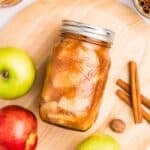

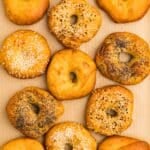

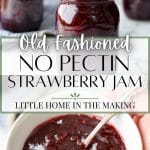



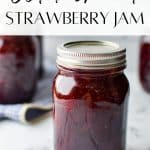
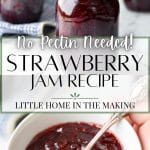

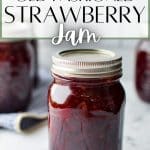



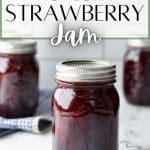

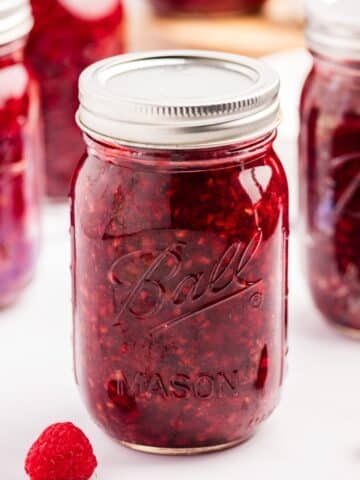



Leave a Reply